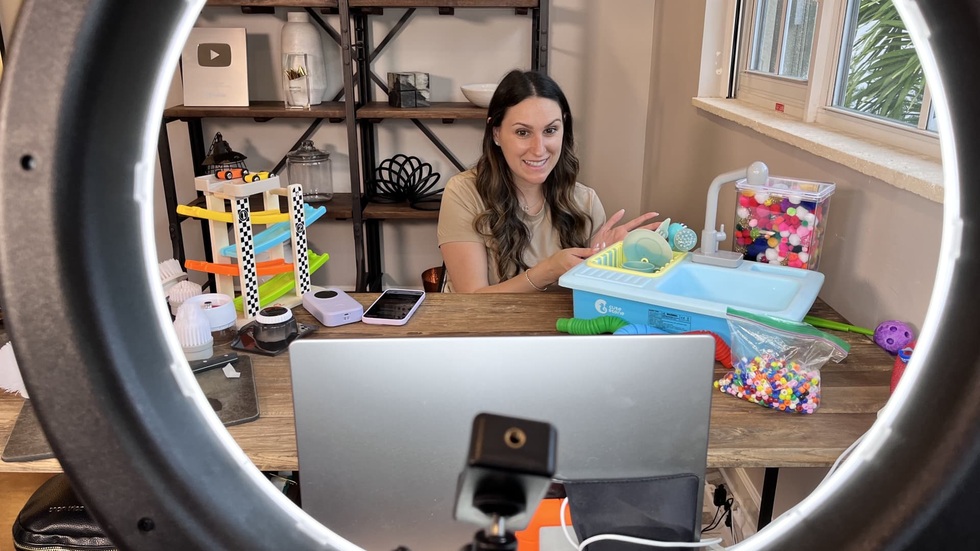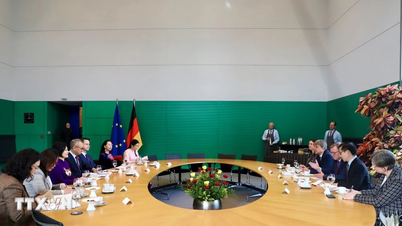Ahead of a special livestream for Amazon Prime Day, British streamer Andrew Martin turned on a warm yellow light and transformed his bedroom into a makeshift studio. For an hour, he demonstrated the recording capabilities of his wireless microphone, walking leisurely from his desk to the sofa next to the cat shelf.
“I think I’ll be fine streaming from this chair,” Martin joked to his viewers watching on the screen. “I don’t need that computer anymore. Just give me a drink and I’ll just sit here and chat.”
Viewers come to Martin not just to find bargains on electronics, but also to chat, interact, and find genuine connection. He is just one of thousands of pieces that make up the booming commercial livestream scene in the US.
But on the other side of the world, in China, stories like Martin’s have been happening for a decade now, on a scale and intensity unimaginable in the West. It’s no longer a casual “chat” session, but a giant sales machine, a billion-dollar industry that operates nonstop, 24 hours a day, 7 days a week.

Beauty blogger Li Jiaqi, also known as the “lipstick king,” tries on lipstick while livestreaming on e-commerce platform Taobao in October 2018 in Shanghai, China (Photo: Getty Images).
When shopping becomes a “sensory feast”
In 2018, at an Alibaba event, Jack Ma challenged Li Jiaqi, a relatively new beauty blogger, to see who could sell more lipsticks on Taobao Live. The future “lipstick king” sold 15,000 lipsticks in just five minutes. That moment officially ushered in a new era for China’s retail industry.
Today, a live stream by Li Jiaqi, with more than 35 million followers on Douyin (the domestic version of TikTok), is a veritable “sensory feast.” Advertising banners flash, promotional pop-ups appear, and hundreds of products are introduced one after another. Once, he tried on 380 different lipstick colors in a seven-hour broadcast.
According to Jacob Cooke, CEO of consulting firm WPIC, the success of this model lies in the perfect combination of three elements: entertainment, discovery and real-time transactions. “It creates a shared social moment where millions of people watch, comment, ask questions. That is something that static product pages on traditional e-commerce platforms can never do,” Cooke analyzed.
The Covid-19 pandemic with its strict “zero-Covid” policy has become a catalyst, turning livestreaming into an antidote to the feeling of confinement, recreating the “shopping at the mall” experience right at home.
Brands and streamers have turned shopping into an addictive game. Tricks like flash sales, countdown clocks, and exclusive discount codes are constantly being released, stimulating FOMO (fear of missing out), forcing viewers to make faster decisions and spend more.
On Taobao, the machine never stops. At 10:30 a.m. on any given day, dozens of live streams are running, selling everything from hairpins to fake nails to umbrellas.
Livestreaming solves one of the biggest problems in e-commerce: trust. The host acts as a curator, a trusted friend, explaining complex technical specifications, trying on a shirt, or applying a layer of foundation.
This is especially effective in categories that need to stimulate emotions and build trust, such as cosmetics, fashion , skin care, and small electronics.
US: The emerging player is accelerating
If China is the mature giant, the US is the emerging player with potential. Over the past two years, commercial livestreaming has started to heat up in this market, driven by two main drivers: the rise of TikTok and the craze for collectibles.
The numbers don’t lie. TikTok Shop sales in the US jumped 165% year-over-year on Black Friday and Cyber Monday in 2024, hitting $100 million. The platform even surpassed big names like Shein and Sephora in sales in 2024.
Livestreaming app Whatnot, which specializes in collectibles, raised $265 million in a Series E round in January 2025, valuing the company at nearly $5 billion. A VTEX survey found that 45% of US consumers had watched or purchased via livestream by 2024.
The explosion of “kidult” culture (adults passionate about childhood hobbies like Pokémon action figures and blind box toys) has fueled the market. Live unboxing shows, where sellers demonstrate the authenticity of products on camera, have become a popular form of entertainment.
On eBay Live, a streamer in Utah can attract 50 simultaneous viewers just by opening a new Pokémon deck. The upbeat background music, the crisp sound of plastic being ripped, the brief commentary on each card, and the hearts constantly dropping on the screen… all create an exciting community atmosphere. Jamie Iannone, CEO of eBay, asserts that livestreaming is the future of the platform, with the collectibles segment alone bringing in $10 billion a year.

Over the past two years, commercial livestreaming has begun to "heat up" in the US (Photo: Getty).
Livestreaming career: The dream of money and the harsh reality
The appeal of livestreaming is the flexibility, the ability to work from home and the opportunity to turn a passion into money. Caleb Wessels, 34, was a makeup artist. When the pandemic left him unemployed, Amazon invited him to become a content creator on its Amazon Live platform.
“Anyone can start. All you need is an iPhone,” says Wessels, who has no fixed schedule and goes online when he feels like it, sharing makeup tips, testing new products, and chatting about his personal life with his close followers.
But behind the glitz lies a tough business reality. Both Wessels and Martin admit that the commissions from livestreaming are not enough to make ends meet. “There are more and more people streaming at the same time, and the audience is fragmented,” Wessels says. “I used to get 100,000 views on a stream, and now I have very few.” To make ends meet, he has to take on a part-time job as an AI trainer.
Martin is in a similar situation. He says his current income is “not worth much” and is shifting his focus to making videos for YouTube, where content has more longevity. “As long as I can pay the rent and feed my cats, I’m happy,” he says.
Their stories reflect a harsh reality: the livestreaming market in the West, while growing, is also becoming more crowded and competitive. Audience fragmentation makes it increasingly difficult for small streamers to make a living, in stark contrast to the model of power concentrated in a few “superstars” like Li Jiaqi in China.
Saturated market or "new normal"?
Comparing China and the US is comparing a mature market and a market in acceleration.
In China, signs of saturation are becoming more evident. After a period of rapid growth (196% in 2020), the growth rate of the livestream market has slowed significantly, to about 27-29% in 2022-2023. Although the size is expected to exceed 1,000 billion USD by 2026, the pie is no longer expanding as quickly as before.
New challenges are emerging:
Fierce Competition: The surge in the number of streamers and providers has caused many people's income to decline.
Weak economy: Consumers tighten spending.
The Rise of AI: Virtual influencers that can replace humans at a lower cost are emerging.
Tightening Regulations: Platforms like Douyin are starting to enact stricter regulations to protect consumers from counterfeit, shoddy goods and misinformation.
Meanwhile, the US is a land of promise. Although livestreaming only accounts for about 5% of total e-commerce revenue (compared to 60% in China), its growth rate is forecast to be the fastest in the world. ARK Investment Management predicts the US market will grow by an average of 47% per year, reaching $680 billion by 2030.
Gen Z, the generation that grew up with social media and short videos, is the core driver of this growth. For them, shopping is not just about transactions, but also a form of entertainment and self-expression.

The livestream sales market in China is in a mature stage, while in the US it is in a period of acceleration (Photo: Cam Ha).
In 1977, a Florida radio station sold out 112 electronic can openers on the airwaves. It was the beginning of the Home Shopping Network (HSN) and the era of “teleshopping.” Nearly half a century later, that spirit is being revived in a big way via the phone screen.
The journey from radio can openers to million-view TikTok livestreams has come full circle. Livestream commerce is not just a rebirth of home shopping, but a true revolution, redefining how we consume, interact, and connect in a world where the lines between entertainment and commerce are blurring.
The machine may be running full speed in China, but in the US and the rest of the world, it is just getting started.
Source: https://dantri.com.vn/kinh-doanh/livestream-247-co-may-ty-usd-khong-ngu-cua-trung-quoc-va-canh-bac-cua-my-20251017110741867.htm


![[Photo] Closing ceremony of the 18th Congress of Hanoi Party Committee](https://vphoto.vietnam.vn/thumb/1200x675/vietnam/resource/IMAGE/2025/10/17/1760704850107_ndo_br_1-jpg.webp)
![[Photo] Collecting waste, sowing green seeds](https://vphoto.vietnam.vn/thumb/1200x675/vietnam/resource/IMAGE/2025/10/18/1760786475497_ndo_br_1-jpg.webp)



![[Photo] General Secretary To Lam attends the 95th Anniversary of the Party Central Office's Traditional Day](https://vphoto.vietnam.vn/thumb/1200x675/vietnam/resource/IMAGE/2025/10/18/1760784671836_a1-bnd-4476-1940-jpg.webp)

































































































Comment (0)